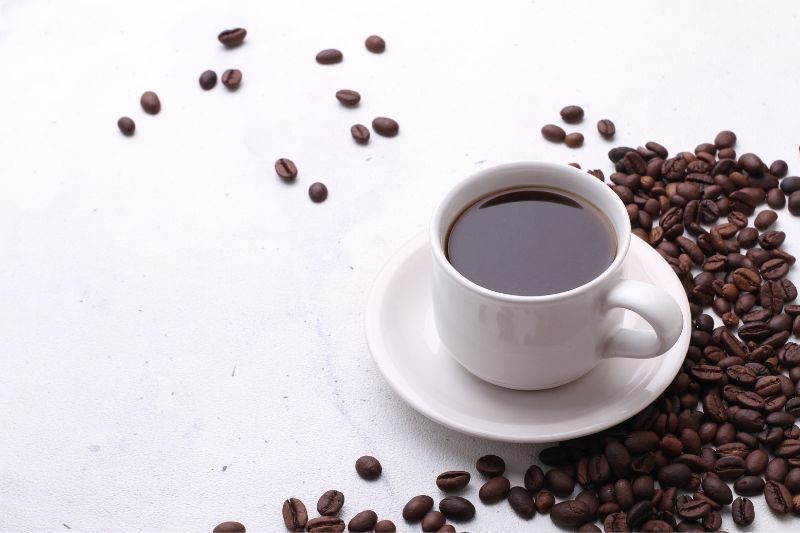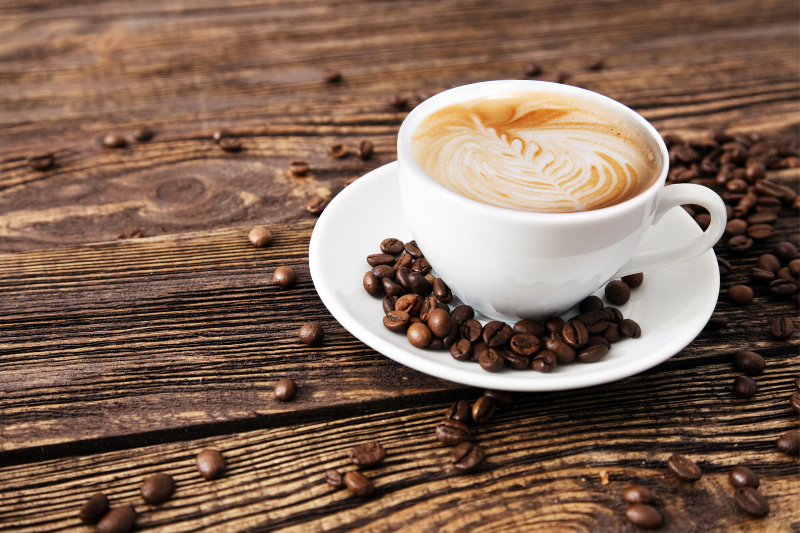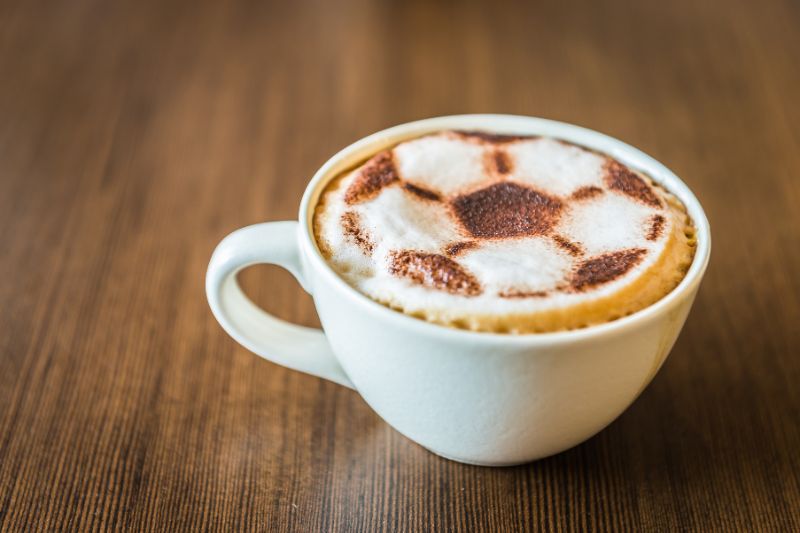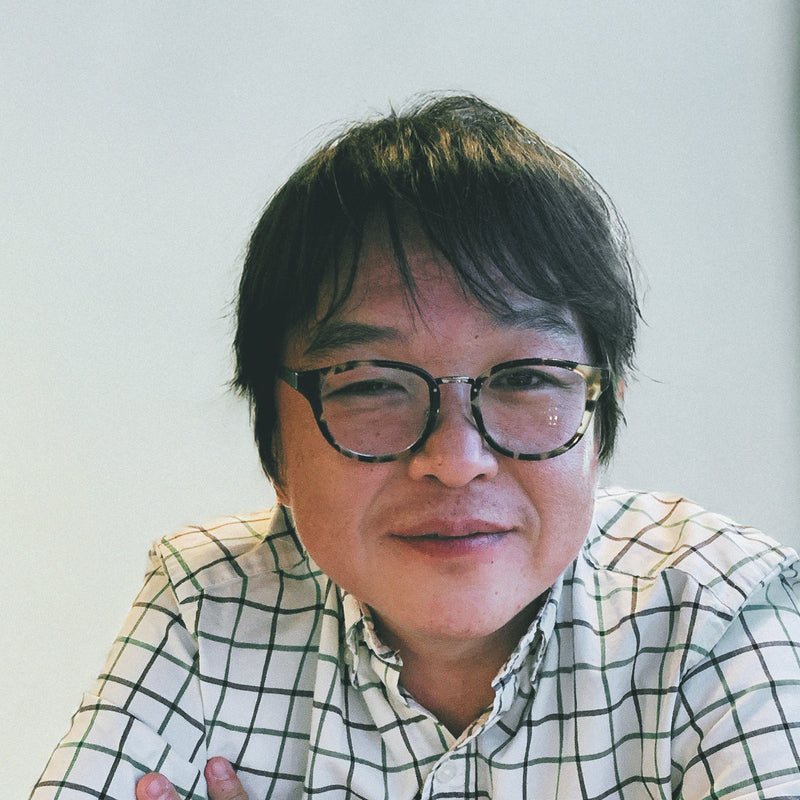“Coffee is balm to the heart and spirit.”
Guiseppe Verdi, the greatest Italian opera composer of the 19th century
So a few weeks ago, I found myself longing for a little holiday. When I thought about where I should go, there was one country calling to the coffee lover in me. I packed up, bought the tickets, took a flight, and the next thing I knew, I was in the land of espressos - Italy.
As you might know, Italy is one of the places on Earth that is considered the coffee capital. For many coffee lovers, visiting Italy is like a holy pilgrimage. The Italian coffee scene stands out among the rest because it is so intertwined with the culture, history, people, traditions, and everything that is gorgeously Italian.

When I stepped outside the airport, the Italian breeze welcomed me, and I was awestruck by the vibrant colors, rich architecture, and the intense passion for life I could feel everywhere around me. Italians are known as the most passionate people in Europe, and I could see why - people are very expressive, talking with both words and big gestures; and there was a commonly shared love for food, drinks, and enjoying life with friends and family. The coffee in Italy reflects this passion for life - Italian coffee is strong, intense, dark, and rich. The most preferred coffee drink in Italy is “the espresso” - a drink that is bold, fast and tingles your brain with caffeine sparks.
However, this trip to Italy has been an eye-opener for me because it helped me discover different aspects of Italian coffee culture. There was so much more to Italian coffee than just espresso and “bitter, dark, and strong.” Today, I would love to share this first-hand account of my coffee experience in Italy. I hope you make a nice cup of coffee and come with me on this exciting journey. “Prendiamo un caffè” (Let’s have a coffee”)!
Different kinds of Coffee drinks you can find at an Italian Coffee shop
Italy might be known as the land of espressos, but you can find a mind-boggling array of coffee drinks in an Italian coffee bar or a cafe. If you find yourself at an Italian coffee shop with only an Italian menu, it can take a lot of work to figure out what to order. Below is a list of drinks you might come across and their descriptions; I suggest you take a screenshot of this list and carry it around with you on your next Italy trip!
- Types of Espresso: Yes! You have read it right. Usually, when we think of Espresso, it is simply a single espresso or a double espresso, but not in Italy! For Espresso alone, there are a good number of variations.
- Caffe (or Caffe Normale): The Italian way to say Espresso is simply "Caffe." When you want to order a single espresso, ask for a "Caffe" instead of saying Espresso, and then watch the barista pull out a gorgeous shot of Espresso for you. This drink is meant to be finished in one to three sips, standing at the espresso bar.
- Doppio: In Italian, Doppio means "Double," You order this when you want that extra caffeine kick from a double espresso.
- Ristretto (also known as Corto or Basso): The word Ristretto means "Restricted," In this context, it refers to the fact that a smaller amount of water is used to pull an espresso. So it is very similar to an espresso but has a more intense flavor and can be sweeter with a smoother mouthfeel. It is also a great option if you want to finish your coffee quickly - in just one sip instead of two or three.
- Lungo: Lungo means "long"; to pull this shot, more water is used compared to the normal Espresso. So it is like a mini-Americano. If you want your Espresso to be a bit lighter but not as light as an Americano, then you might want to order this.
- Shakerato: Shot of Espresso shaken in a cocktail shaker with ice. A summer favorite for espresso lovers.
- Macchiato (or Macchiato Caldo) : A shot of espresso with a dollop of foamed milk on top. Macchiato means "Spotted or Stained", as in the Espresso has just a spot of foam.
- Macchiato Freddo: A single shot of Espresso with a splash of cold milk.Caffe Cortado: A shot of Espresso with an equal amount of steamed milk added to it so that it is not as acidic and strong as an espresso.
- Corretto: A shot of Espresso with a tiny amount of liquor such as grappa, brandy, or sambuca.
- Al Vetro: When you order any espresso drink "Al Vetro," it means the drink will come in a small espresso glass instead of a cup. Drinks such as Espresso, Macchiato, and Corretto can be ordered "Al Vetro."
- Americano: Espresso diluted with the addition of hot water.
- Cappuccino: A drink that contains equal parts of Espresso, steamed milk, and steamed milk foam.
- Caffe Latte: Made by adding steamed milk to an espresso, with a smooth, thin layer of foam on top. Point to note: In Italy, if you order just a "latte," you will get plain steamed milk. If you want the coffee drink, you have to order a "Caffe latte".
- Mochaccino: This is what we call the "Mocha" in the states. However, in Italy, a drink made with coffee, steamed milk, and chocolate is known as Mochaccino. Point to note: In Italy, Mocha usually refers to the Moka pot coffee, the coffee you make in an Italian stove top Moka pot such as Bialetti. (see more about Bialetti below)
- Caffè d'Orzo (or just Orzo): Another marvelous Italian invention, Caffe d'Orzo is a drink that resembles coffee in taste and appearance but is made with roasted barley, with the great advantage of being caffeine-free.
- Caffè Ginseng: A shot of Espresso mixed with ginseng root extract. It is believed to aid in digestion and provide energy.
- Marocchino: Marrochino means "the Moroccan," which originated in the Northern Piedmont region. The name comes from the fact that the drink's color resembles the color of light brown Moroccan leather. The drink is made by layering cocoa powder, cream, and coffee.
- Caffe Monte Bianco: A coffee drink with foamy milk on top. The name refers to the mountain "Monte Bianco," which has a snowy white peak.
- Creme di Caffè: This is a summer staple in Italy and is made by churning ice, sugar, cream, and espresso coffee in a machine. It has a thick, creamy texture like a velvety iced coffee shake.
- Caffè con Panna: A single shot of Espresso topped with whipped cream.
- Affogato al Caffe: A spoonful of vanilla or plain gelato 'drowned' in a shot of Espresso.
- Caffe Borgia: A refreshing coffee drink made with coffee, chocolate, cream, and orange zest. I made a more complete list here if you want to see them all
Visiting a Bialetti store - A treasure land for the fans of Italian Moka stove top coffee maker
If you are a fan of Italian Moka pot coffee, you might have come across the instantly recognizable logo of a mustached man in a suit, pointing his finger at the sky as if he is saying, "It's time for an espresso!" The mustached man you see is the logo of a globally famous Italian home coffee machine brand - Bialetti (Est. 1933). This logo, "L'omino con i baffi" – the Moka mascot," was inspired by the company's founder Alfonso Bialetti's son, Renato's humorous cartoon drawing.
While walking around in Italy, I saw Bialetti shops everywhere! It is no surprise that a study in 2010 found that almost 90% of Italian families have a Bialetti Moka pot at home. So when I saw the first Bialetti store in Italy, I had to go inside, as I personally own a Bialetti Moka pot and use it often to make Italian espresso at home. The store was bright and colorful and had home coffee brewing machines, coffee drink ware such as cups and flasks, coffee beans, and coffee grinders.
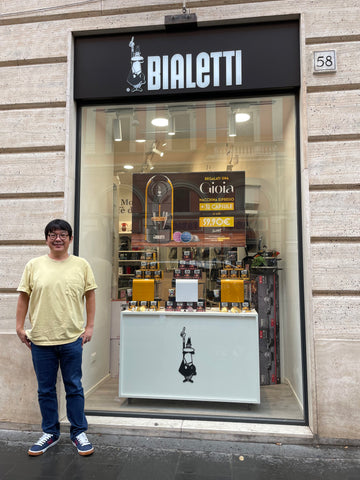
In front of the first Italian Bialetti shop I visited. You can see the Moka Mascot right beside me!
I was blown away by the sheer amount of options and variations the products offered in terms of colors and sizes. In the US, I hardly come by Moka pots in colors other than plain aluminum, silver, black, or red. However, the Italian Bialetti shops offered Moka pots in more stylish shades such as pastel mint green, bright yellow, fuchsia pink, azure blue, etc. They even had a Moka pot with a green upper part and a red lower part, representing the Italian flag!


So many options! You can also see the Bialetti Moka pots in Fuschia pink. They also sell coffee beans, espresso cups, and coffee flasks with beautiful designs
One thing that I was disappointed with was their coffee grinder section. They only had a spice-grinder type coffee grinder, and any coffee lover will know that it is not a good machine for grinding coffee beans. Spice-grinder style grinders create non-uniform coffee grinds, which can result in under or over-extraction, making the coffee taste too acidic, unpleasantly bitter, or watery. A good coffee grinder is indispensable for a great cup of coffee.
Starbucks in Italy - How Starbucks has survived where Domino’s has failed
Most of us look for the nearest Starbucks store when we crave a cup of coffee after landing in a foreign land. The same must be for people visiting Italy; however, Starbucks lovers have been lucky in the land of espresso, well, at least until 2018.
During my trip to Italy, I have not seen a single Starbucks store, although Starbucks does exist in Italy. It makes complete sense, though, when you consider that there are only 11 Starbucks locations all over Italy. This number is a minimal number when compared to the number of Starbucks locations in other European countries such as Turkey (536!), the UK (748!), or even Japan (over 1600!!!). (as of 11/2022)
Italy is one of the most challenging markets for foreign food and beverage companies. After trying hard to expand to Italy since 2015, Domino’s, another American company, has closed the last of its Italian branches this year. Starbucks, on the other hand, is still going strong in Italy since opening its first Reserve Roastery Store in Milan in 2018.
Many might argue that the tourist population of Italy (65 million tourists per year (in 2019), the fifth most visited country in the world) accounts for the success of Starbucks, but I don't think that is the only reason. Other factors lead to Starbucks gaining popularity not only among the tourists of Italy but also among the locals. In a news channel interview, a young Italian customer of Starbucks was filmed saying,
"I prefer Starbucks because it is cooler; there is something more hip, something more American."
From my personal experience of Italy, I was pleasantly surprised to find out that people in Italy actually like America. Italy, especially Milan, is known as one of the world's fashion capitals. Some of the biggest names in today's high fashion, such as Versace, Prada, Georgio Armani, Gucci, and Fendi, are from Italy. So it was fascinating to see that many people in Italy fashionably wore clothing with names of American cities such as New York, Los Angeles, and Chicago. In addition, we must all be familiar with the iconic Levi's, a classic American brand. However, these days, American Levi's shops are deserted unless they have a big sale. In Italy, Levi's seems to be considered fashionable, and I spotted many people in the streets of Italy wearing Levi's jeans. Levi's stores in Italy were more polished, had a stylish look, and had more customers than I would see in Levi's stores in the states.
American culture and its brands are deemed to be trendy, cool, and in style, especially among the younger generation. So in Italy, Starbucks coffee is not just coffee - if you are walking with a Starbucks drink in your hands, it is like having a special social status; it is like a statement accessory that elevates any outfit.
There is another exciting story about the relationship between Italy and Starbucks. Did you know that the original concept of Starbucks was inspired by the coffee culture in Italy? In the beginning, Starbucks was a wholesale coffee beans shop, a very different concept compared to what Starbucks is today. In 1983, Howard Shultz, the marketing director of Starbucks at the time (currently the interim CEO of Starbucks), visited Milan on a business trip. He was deeply touched by the sense of community in the coffeehouses in Italy. In an interview,
Shultz described his experience of being inspired by the Italian coffee culture to create the current Starbucks concept:
"In each shop I visited, I began to see the same people and interactions, and it dawned on me that what these coffee bars had created, aside from the romance and theater of coffee, was a morning ritual and a sense of community,"
"I left Italy absolutely energized by the culture,".... "I couldn't wait to sit down with the two remaining founders of Starbucks and tell them, 'We've got to do this.'"
Even though Italy and Starbucks share such a deep story, it took Starbucks 47 years to open its first store in Italy. In the beginning, it was quite challenging for Starbucks. When Starbucks went public with its plan to expand to Italy, the announcement was met with severe backlashes in social media. When Starbucks planted 42 palm trees in front of the historical Piazza Del Duomo to celebrate its first Starbucks location in Italy, protesters set fire to the trees at night! However, Starbucks did not give up, and today it is thriving in Italy.
Visiting a third-wave coffee shop in Italy - Is third-wave coffee popular in Italy?
In Japan and the States, there seems to be a third-wave coffee shop around every corner. However, in Italy, that is not the case. In the Italian coffee scene, ‘third wave’ or specialty coffee is still a rarity that exists in small numbers only in the big cities.
We all wonder why did third-wave coffee culture not gain popularity in Italy. However, there are a couple of logical reasons for this question. First, espresso-based drinks are much cheaper, faster, and traditionally more accepted in Italian culture. Also, when it comes to the pricing, the third-wave coffee drinks priced at 3 - 4 Euros are much more expensive compared to an espresso which can be bought at around 1 Euro. So for an average Italian, espresso-based drinks are much more affordable. In addition, most coffee beans in Italy are dark-roasted beans more suitable for brewing using an espresso machine than third-wave methods such as pour-over or Aeropress.
However, I had the pleasure of visiting an excellent third-wave coffee shop in Italy, which is my favorite cafe from my trip to Italy. The name of the coffee shop is Pergamino Caffè, located near the Vatican Museums in Rome. A third-wave coffee shop in Italy has to maintain top-notch quality and work many times harder than usual to survive the tough challenges mentioned above. The fact that Pergamino Cafe has overcome all those hurdles and is still going strong since as early as 2016 near the Vatican, the very heart of Italy, says a lot about this cafe.

You can see my smile after finding a great third-wave coffee shop in Italy. The hand-written menu board also adds a homely feeling to the cafe front

Photos of the cafe interiors and drinks
Romanesque interiors made of wood, arched doorway, uneven stone walls, and warm lights add to the atmosphere inside the cafe

You can see that they are selling coffee beans and other coffee-related goods inside the shop. Perfect souvenirs for my friends and family back home!
Another thing that I was surprised by is that smoking cigarettes is quite common in Italy. Most cafes and Pergamino included have an outside seating area where people can sit and enjoy their coffee and smoke with their coffee.

Photo of Moka pot bottom as an ashtray
It was interesting to see that the Moka pot bottom was placed on the outdoor tables as ashtrays!
Of course, the outdoor seating is not just for smoking. It is somewhere that you can sit and soak in the glorious Italian sunshine, watch people walk by in fashionable clothing, and be close to the glamorous vibe of the city.
As you can see on the menu, although third-wave cafes are few and far between in Italy, once you find a third-wave cafe, they offer a wide variety of options to satisfy any third-wave coffee fan. For example, at Pergamino Cafe, they have Batch Brew (automated drip coffee brewed in batches), French Press, Siphon, Chemex, Cold Brew, V60 pour-over, Aeropress, etc. They also serve espresso-based drinks such as Americano, Cappuccino, Espresso, etc.

Although I was lucky to have found Pergamino Cafe, most other cafes or coffee bars did not serve anything other than espresso-based drinks. Most cafes also have only one type of coffee bean. By the end of the trip, I was greatly missing the pour-over coffee that was easily available back home.

Interesting things I have encountered on the streets of Italy
Once I had my coffee at Pergamino Cafe, I took a stroll around the beautiful city of Rome. It was simply fascinating. I came across some Japanese anime, such as Goku (Dragon Ball) and Naruto, in the exteriors of fashion outlets. Walking around Rome, I noticed that even the garbage bins are organized stylishly.



Photos of Naruto, Dragon Ball, and garbage bins.
I also was interested in checking out the quintessential American brand McDonald's in Italy. I had to try a coffee from McCafé, which was much better than the McCafe coffee back in the States!


Photos of Big Mac and McCafe
Trying out the standing Espresso bars in Italy.
You might have heard about a unique Japanese street food called "Tachi-soba" or "Eki-Soba." Soba, like Ramen, is a noodle dish in Japan made of buckwheat. The unique thing about "Tachi-soba (Eat while standing Soba)" or "Eki-Soba (Train station Soba)” is that it is an "On-the-go" food, meaning the customer will come in, order the soba-noodle, and eat it while standing at the bar or counter and leave right away when they are done. Interestingly, a similar concept exists in Italy, the only difference being that it is coffee rather than Soba.
In Italy, there are coffee shops called 'coffee bars.' Although by bars, we usually understand an establishment that serves alcohol, in Italy, it means a coffee shop where the coffee drinks are enjoyed in a sip or two, very fast, at the bar or counter. People usually have espressos at these shops, as they can be finished in one to three sips, and it is like a battery charging station where people can come and have their delicious caffeine shot to re-energize them in the middle of their word day.
I had heard so much about the standing espresso bars in Italy that I could not miss out on trying this experience during my Italy trip. So, I stopped at a Lavazza espresso bar and ordered my quick coffee. The whole process was speedy, from ordering to receiving the freshly brewed espresso coffee and paying. Also, Lavazza is a huge coffee company in Italy and has countless outlets all over the country. It is as if Lavazza is the Starbucks of Italy.

Photos of Lavazza espresso bar
Coffee war in Italy - Lavazza Vs. Illy
In Italy, the coffee war is extremely competitive. Two companies that dominate the market are Lavazza and Illy. Not only in Italy, but you will see their products everywhere in Europe and also worldwide. As I have mentioned in the last section, Lavazza has a seemingly infinite number of stores across Italy, and almost all cafes in Italy use coffee from either Lavazza or Illy, proudly showing the ‘Illy’ or ‘Lavazza’ brand names at the storefront. Even at the hotels we stayed in, we discovered that the rooms were equipped with proper single-serve coffee machines, either by Lavazza or Illy, which came with their original coffee pods.

Photo of single-serve Illy coffee pods
Lavazza originates in the beautiful and economically important city of Turin in Northern Italy. It was founded in 1895, started as a small family-run grocery shop, and is now a multinational company with an annual revenue of €2.24 billion! Lavazza uses a mixture of Robusta and Arabica beans in their blends. Its use of Robusta beans allows Lavazza to market its coffee beans at a slightly lower price than Illy. Although Lavazza coffee is not 100% Arabica, there is no question about the quality of its coffee blends. It has an earthy, dark flavor with a rich, thick crema.
Illy was founded in 1933 by Francesco Illy, who moved from Vienna to Trieste with a dream to create the best coffee in the world. As we all know, Vienna is the birthplace of cafe culture in Europe. Trieste in Northern Italy is considered a coffee center with double coffee consumption per person compared to the rest of Italy. Illy uses 100% Arabica coffee beans in their blends, and although the price is a bit higher than Lavazza, Illy is the better choice if you prefer to make coffee using methods such as drip or french press. In addition, Illy coffee blends have a sweeter and more delicate taste compared to Lavazza coffee.

Photos of Illy Caffe
A mind-blowing discovery on the train from Rome to Venice: a full-fledged vending machine dedicated to coffee!
A trip to Italy for a coffee lover would be incomplete without visiting Venice. Why? It is a bit like you would not miss out on Kyoto if you were a tea-lover and went to Japan. Venice was one of the first places in Europe where coffee became available to the general public during the 17th Century. In the beginning, it was only sold as medicine. Still, cafes serving coffee started to open slowly, and these cafes were the birthplaces of revolutionary ideas and social and artistic movements. So when you go to Venice, you will see that coffee is not just coffee. It is the heart of the art, history, tradition, and culture of the city.
We took a special train from Rome to Venice - the train is called Italo, designed by the legendary Italian car manufacturing company Ferrari. The super sleek, burgundy-red Italo train is known as the “Ferrari on rails,” and I was amused to be able to take a ride on an Italo. Inside the train, another big surprise came to me in the form of a super customizable coffee vending machine catered by none other than Lavazza!



Photo of the vending machine on the train
Japan is known for its widely available vending machines (see my article about Japanese Vending Machine here), so it was not the presence of a vending machine that surprised me but rather how many options were available for just espresso. As you can see in the photo, the vending machine offers Espresso, Lungo, Macchiato, Cappuccino, etc., not just with the regular coffee beans but all of the drinks in Decaffeinated (Caffeine-free) and Ginseng versions. It also had chocolate-based drinks, plain hot milk, and tea.
Another thing about the machine that impressed me was the hopper full of fresh whole coffee beans attached to the machine, which means that for each of the drinks ordered through the machine, the coffee beans are freshly ground (not from pre-ground coffee powder), and then brewed into your cup. Simply Wow!
Bittersweet coffee experience in Venice
Upon arriving in Venice, I wasted no time having my first-hand coffee experience in the gorgeous city of Venice. However, my coffee experience in Venice has not been a bed of roses but rather a bit bittersweet, like a tiramisu.
The first cafe I went to, where I had my 'bitter' part of the experience, was Caffe Florian. Caffe Florian is famous for being one of the world's oldest and longest-running coffee shops (the oldest in Italy). It was established in 1720, so it has more than 300 years of history! It also houses many iconic art pieces, so it is like sitting inside a museum and sipping on a cup of coffee. As you can imagine, sitting inside Caffe Florian is a remarkable experience, but sadly, when I arrived there, the service I was met with was quite unwelcoming and disappointing. I was even eager to wait on a list, but they did not allow it. Of course, I understand if a cafe is busy, fully booked, and unwilling to add more to its waiting list. Still, I was expecting better handling of the situation by the servers, especially at such a well-known establishment.

Photo in front of Caffe Florian
Putting a smile for the photo but a bit disappointed by Caffe Florian
However, I did not linger on the bitter taste. I looked forward to visiting another Venetian cafe - Caffè del Doge, which gave me the 'sweet' part of my Venetian coffee experience.
Caffe Del Doge is an iconic coffee shop with its own coffee roasting section in Venice, with a cult-like following among both tourists and locals. It was founded in 1952 and started as a specialty coffee roasting plant. The roasting plant quickly became a sensation in Venice, attracting coffee lovers, cafe owners, and people in general, as they started to come from far and beyond to buy Caffe Del Doge (Known as ExtraDoge at the time) 's delicious freshly roasted coffee beans.
Today, Caffe Del Doge is a larger establishment and caters to coffee lovers from all over the world, exporting their coffee beans beyond Italy. They also make their own Nespresso-compatible coffee pods as well.
I had a fantastic time at Caffe Del Doge, and as you can see in the photo, they have a selection of more than 14 different types of coffee beans (!) you can choose. These coffee include blends and single origins, and they are all 100% Arabica beans sourced from the world's best coffee-growing regions. Some of the fantastic seasonal single-origin roasts they offer are Ethiopia Yirgacheffe Abaya Lake, Guatemala Huehuetenango, China Fengmi Dragon, India Plantation AA Chandragiri, Costarica Tarrazu St.Raphael, and Brasile Mogiana Cav. Rizzardini.

Photo of the Coffee bean dispensers at Caffe Del Doge
Just looking at the names of the single-origin coffees tells you that it is a specialty coffee shop, but the best part is that it is like a third-wave coffee shop with an Italian twist. They serve delicious Italian desserts such as Cannoli (a fried dough pastry tube filled with sweet and creamy ricotta-based filling).


Photo of Coffee and Cannoli at Caffe Del Doge
Another amusing finding on the walls of Caffe Del Doge was a framed certificate from Specialty Coffee Association (SCA)! Caffe Del Doge is part of SCA Europe, and SCA trainers always check the coffee standard at Caffe Del Doge. It was a delightful surprise for me as Sapporo Coffee Kan is part of the same association's Japanese branch.
 Photo of the certificate
Photo of the certificate
Spoiled with options - Coffee sections in Italian Grocery Stores
I found I could buy specialty coffee beans in Italian coffee shops, but then the question came to my mind: What about regular grocery stores? Do they have a good coffee selection? I went to my absolute favorite Italian grocery store, Eataly, which also has branches in Los Angeles and Las Vegas, to find out.
At Eataly, they had an amazingly diverse coffee section. They even had a coffee shop inside the store run by Illy.

Photos of coffee sections at the grocery store
You can see in the photos that they have many different kinds of whole beans, ground coffee, coffee pods, Instant coffee, and various brands for each type of coffee.
I almost bought a Coffee Encyclopedia!
In Italy, people share a widespread love for literature and reading. We passed by many bookshops in the streets of Italy, and the bookshops had many customers too. I decided to check out the coffee and tea section in a bookshop. The tea section was tiny, and music-related books took over even that small section. The coffee section was enormous in comparison - it had many interesting books about coffee. One of the books from the coffee section that caught my eye was a coffee encyclopedia, and I was almost ready to take it to the counter and buy it. Just before I paid for it, I remembered that I had limited space in my suitcase, thanks to all the coffee beans I had been buying around Italy. So sadly, I had to put the book back on the shelf, but I whispered to it, “I am going to come back for you someday.”
 Photos of bookshop
Photos of bookshop
Arrivederci to Italy
With my secret promise to the coffee encyclopedia, I had to come to terms with the fact that my amazing trip to Italy was nearing its end. However, I found solace in the Italian word for Goodbye - Arrivederci, which means “till we meet again.” So on that note, I said Arrivederci to my wonderful coffee experience in Italy!
Get Free Bonus Books

Sign up for free to the Coffee Club to get advice and exclusive articles about how to choose Japanese Coffee, and tips, tricks, and recipes for enjoying Japanese coffee.
About the author
Kei Nishida
Author, CEO Dream of Japan
Certification: PMP, BS in Computer Science
Education: Western Washington University
Kei Nishida is a passionate Japanese tea and coffee connoisseur, writer, and the founder and CEO of Japanese Coffee Co. and Japanese Green Tea Co., both part of Dream of Japan.
His journey began with a mission to introduce the world to the unparalleled quality of Japanese green tea. Through Japanese Green Tea Co., he established the only company that sources premium tea grown in nutrient-rich sugarcane soil—an innovation that led to multiple Global Tea Champion awards.
Building on this success and his passion for Japanese craftsmanship, Kei expanded into the world of coffee, pioneering the launch of Japanese Coffee Co., the first company to bring Sumiyaki charcoal-roasted coffee to a global audience. His dedication to authenticity and quality ensures that this traditional Japanese roasting method, once a well-kept secret, is now enjoyed worldwide.
Beyond tea and coffee, Kei has also introduced Japan’s legendary craftsmanship to the world through Japanese Knife Co., making handmade katana-style knives—crafted by a renowned katana maker—available outside Japan for the first time.
Kei’s journey continues as he seeks out and shares the hidden treasures of Japan, one cup and one blade at a time.
Learn more about Kei

